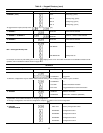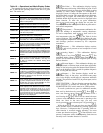
STATUS FUNCTION — This function shows the rotating
display, current status of alarm and alert (diagnostic) codes,
capacity stages, operating modes, chilled water set point, all
measured system temperatures and pressures, superheat val-
ues, pressure switch positions, analog inputs, and switch in-
puts. These subfunctions are defined on pages 36 and 37.
(Rotating Display)
(Alarms/Alerts) — Alarms and alerts are messages
that one or more faults have been detected. Each fault is as-
signed a code number which is reported with the alarm or
alert. See Table 10 for code definitions. The codes indicate
failures that cause the unit to shut down, terminate an option
(such as reset) or result in the use of a default value as set
point.
Up to 10 codes can be stored at once. To view them
in sequence, press to enter the alarm/alert dis-
plays and then press to move to the individual dis-
plays. Press after a code has been displayed. The mean-
ing of the code scrolls across the screen. See Example 1.
Example 1 — Reading Alarm Codes
KEYPAD DISPLAY
COMMENTS
ENTRY RESPONSE
TUE 12:45
LOCAL ON
CLOCK ON
13 MODE
8 MODE
COOL 1
2 ALARMS
3 MINS
Keypad has not been used for
at least 10 minutes. Alternating
summary display appears on
screen
2 ALARMS 2 alarms/alerts detected
RSAL DSB Reset all alarms/alerts
ALARM 9 First alarm/alert code
COOLER LEAVING
FLUID THERMISTOR
FAILURE
Explanation of alarm/alert code
ALARM 42
Second alarm/alert code.
Cooler freeze protection
COOLER FREEZE
PROTECTION
Explanation of alarm/alert code
When a diagnostic (alarm or alert) code is stored in the
display and the machine automatically resets, the code is de-
leted. Codes for safeties which do not automatically reset
are not deleted until the problem is corrected and either the
machine is switched to STOP position, then back to LOCAL/
ENABLE or CCN position, or by using the keypad and dis-
play module.
To reset alarms/alerts using keypad and display module:
KEYPAD
ENTRY
DISPLAY
RESPONSE
COMMENTS
RSAL DSB
Reset all alarms/alerts
function disabled
RSAL ENB
Reset all alarms/alerts
function enabled
(Modes) — The operating mode codes are dis-
played to indicate the operating status of the unit at a given
time. See Table 10.
To enter the MODES subfunction, press and
press the key to determine if more than one mode ap-
plies. See Example 2 to read current mode with expansion.
Example 2 — Reading Current Operating Modes
KEYPAD DISPLAY
COMMENTS
ENTRY RESPONSE
TUE 15:45
LOCAL ON
CLOCK ON
8 MODE
COOL 1
0 ALARMS
3 MINS
Keypad has not been used for at
least 10 minutes. Rotating summary
display appears on screen
2 MODES There are 2 modes currently in effect
LOCAL ON Unit is on by chiller on/off switch
8 MODE Temperature reset is in effect
(Stage) — This subfunction displays the capac-
ity stage number. See Tables 4A-4C for compressor loading
sequence. To enter the STAGE subfunction, press
and press the to display the stage number.
Continue pressing for the following information:
• Number of requested stages.
• Percent of total unit capacity being utilized.
• Percent of each circuit capacity being utilized.
• Percent of total capacity available.
• Percent of capacity available in each circuit.
• Demand limit set point in effect (can be any value be-
tween 0% and 100%).
• Status of each compressor relay. When a compressor is
on, the number of that compressor is displayed. If a com-
pressor is off,a0isdisplayed. For example: In a given
circuit, if compressors 1 and 3 are running, and 2 and 4 are
not running, 0301 is displayed for that circuit.
• Load/Unload factor for compressors. This factor is an in-
dication of when a step of capacity is added or subtracted.
Its value can range from slightly less than –1.0 to slightly
more than +1.0. When load/unload factor reaches +1.0, a
compressor is added. When the load/unload factor reaches
–1.0, a compressor is subtracted. If compressor unloaders
are used, at –.6 a compressor is unloaded and at +.6, a
compressor is loaded up.
36


















